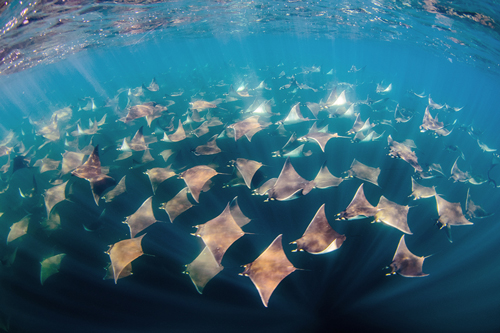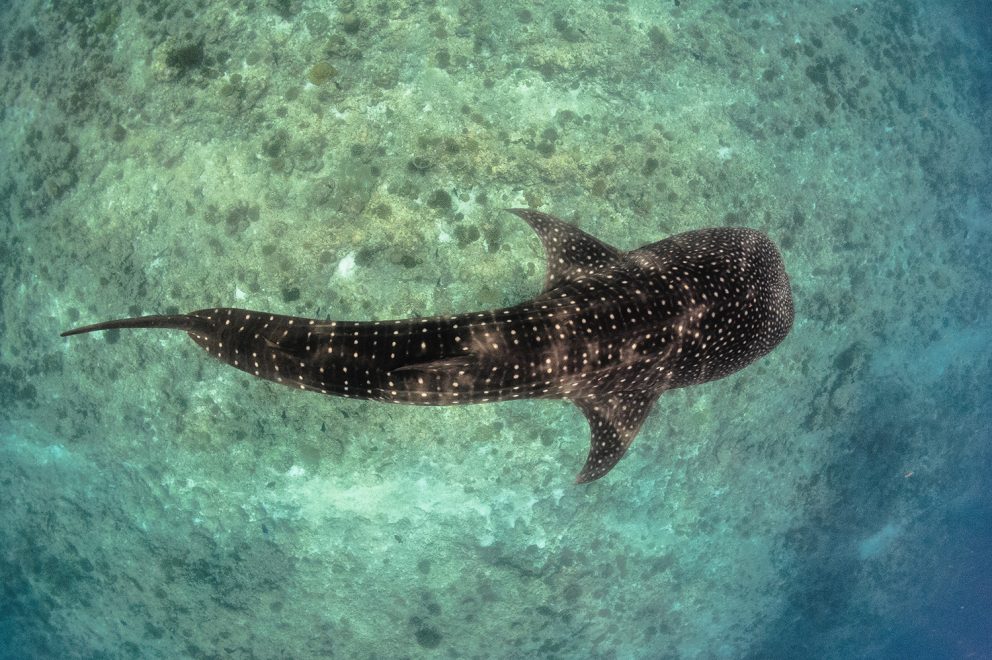Imagine jumping in the water and swimming with one of the largest creatures on the planet! Swimming with these gentle giants is such a unique experience and La Paz, Mexico is one of the best places in the world to spot the whale shark. Before you join us on a whale shark expedition in La Paz, let’s learn a bit more about the whale shark!
Table of Contents :

The Whale Shark (Rhincodon Typus): Description and Behavior
Species Description
The whale shark (Rhincodon Typus) is a non predatory, filter-feeding shark, meaning they capture suspended food particles in the water. They are the only species represented in the Rhincondontidae family, making the whale shark a fish, not a whale.
In fact, it’s the largest fish in the world, measuring an average length of 40 feet. They can grow to a maximum size of around 65 feet and weigh up to 20 tons. Whale sharks are the second-largest animal in the world, second only to whales. The massive creatures have an average life span of 70 years, but some have been known to live to be more than 100 years old.
These giant fish are known for their gorgeous skin. Its dorsal surface has a distinct colored pattern with light spots and stripes that contrast against the darker background, creating a checkered look. This unique skin pattern can be used as a fingerprint to identify specific individuals.
By taking a picture and sending it to the SharkBook database, you can report your whale shark sighings to help scientists study and track their movements. You can also identify your whale shark and gather information from the photo-identification library.
Distribution and Habitat
The whale shark is a highly migratory species capable of traveling up to 8000 miles (Eckert and Stewart, 2001). That being said, there are a few places where groups can be observed in a seasonally predictable way, thanks to their dependence on food.
Typically whale sharks thrive in water temperatures between 82 and 90 degrees. They can, however, remain for prolonged periods at significant depths with temperatures reaching as low as 50 degrees.
Diet and Feeding Habits
It’s crazy to think that such a huge shark eats the smallest things in the ocean! The whale shark is a species that feeds by filtering large amounts of water. To do this, they will move slowly near the surface of the ocean and use their gills to process over 6,000 liters of water every hour. They are able to eat massive amounts of plankton by vacuuming water into their mouth and filtering it out through their gills.
While they feed mostly on a wide variety of plankton, they do occasionally eat larger prey such as tuna, mackerel, or squid. They can also include phytoplankton and macroalgae as part of their diet.

Reproduction
Whale sharks are ovoviviparous, which is like a combination of egg-laying and giving birth to live young. The embryo develops inside an egg that remains in the mother’s body. The egg hatches internally, and then the females give birth to up to 300 live pups. Their exact gestation period is unknown.
Babies are born measuring between 20 and 23 inches and weighing around 2.2 pounds. It is believed that mothers take care of their young in the area where they were born, but sightings of baby whale sharks are extremely rare. A juvenile whale shark is estimated to consume 46 pounds of plankton per day.
Males and females reach sexual maturity when they are about 26 feet in length. It takes the females much longer than males. At this length, or slightly larger, it is estimated that females reach reproductive status. It typically takes 25-30 years for whale sharks to reach maturity. This slow growth contributes to their vulnerability.
Conservation status
Unfortunately, the whale shark is considered an endangered species by the IUCN. They are in danger of being on the verge of extinction. Their biggest threats are fisheries and the demand for shark fins, liver oil, and meat. Luckily, steps are now being taken to combat the decline of the whale shark.
To learn more about whale shark conservation efforts, take our PADI AWARE Shark Conservation Course at Cabo Private Guide. You can also join an association that works towards protecting these gentle giants, like WWF, Empty the Tank, or Green Fins.

Why Whale Sharks Migrate to Baja California and the Bay of La Paz
The Bay of La Paz is one of the privileged places in the world where whale sharks return year after year in a predictable manner. This is likely due to the high biodiversity in the area. You can even enjoy diving wwith sea lions in the Bay of La Paz!
Spanning 1615 square miles, the Bay of La Paz is a national protected marine area. It’s next to La Paz Island and the Espiritu Santo National Park, which is run by the National Commission of Natural Protected Areas (CONANP).
Whale Shark Season in La Paz
The best time for whale shark sightings in La Paz is from October until April. Whale sharks’ migration patterns correlate with high food density and strong tidal currents near the channel that connects the bay with a coastal lagoon in La Paz. When they are not near La Paz, they migrate to other areas in search of food.
Depending on whale shark sightings, the season varies a little bit from year to year. The season is officially open when there have been at least five whale sharks spotted inside the protected marine area of La Paz.

Whale Shark Migration in Baja California
Whale shark migration patterns and aggregations are associated with streams of high primary productivity and nutrient upwelling zones. These areas generally correspond with local phytoplankton blooms or fish and coral spawning. It’s believed that some whale sharks are faithful to the same sites for years on end.
In the Gulf of California, the whale sharks follow physical and biological oceanographic patterns to find the areas that have an abundance of food available. Many other different kinds of sharks can be encountered around Cabo San Lucas. For example, Bull sharks and even Hammerhead sharks can be spotted.
After learning more about the whale shark, you must be looking forward to joining us on a whale shark expedition! On our website, you can find more details and booking information about our Swim With the Whale Shark excursion.








